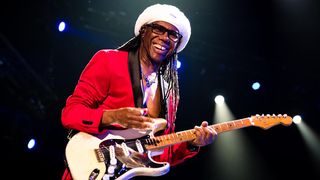A fierce funk movement that developed during the thriving nightclub scene of '70s America, disco funk is a much aligned – and misunderstood – genre, perhaps best represented by the infamous Studio 54 in Manhattan.
Unlike earlier funk, this music was much more heavily produced, and more costly, too, with the addition of lush string sections and more complex arrangements. Here, I'll be delving into the styles of three of disco funk's most influential champions: Nile Rodgers, Claydes Charles Smith and Al MacKay.
One of the most prolific funk guitar players known for this style is Nile Rodgers. Best known for his work with Chic and Sister Sledge, Rodgers' incredible career as an artist, producer and writer has seen him sell cumulatively over 100 million albums.
The incredible roster of artists in his production back catalog include Madonna, Diana Ross, David Bowie, Jeff Beck, Duran Duran and Daft Punk. His instantly recognizable style draws upon jazz and R&B, with multi-layered lines that are put together with impeccable feel and timing.
Claydes Charles Smith is not a household name, but his work with the multiple platinum-selling Kool & The Gang was a continuation of the James Brown school of part writing, mixed with a jazz sensibility that drew on influences such as Wes Montgomery and George Benson.
His style uses octaves, syncopated single-note lines and choppy partial chords, all of which created the rhythmic backbone of a string of iconic songs spanning early funk, classic '70s disco and '80s pop.
Al MacKay was part of hit-making legends Earth, Wind & Fire, a band whose music has spanned many different genres including R&B, pop, soul, funk, Latin and, of course, disco.
MacKay helped pen classics such as September and Sing A Song as well as helping to write Best Of My Love for the Emotions alongside Maurice White. His signature style is all about shiny, jangly funk chords and overdubbed single-note lines. These are brought together with a slightly more complex harmonic sensibility and a penchant for effects such as phaser, chorus and digital delay.
Example 1. Chic-style disco groove
The first example is a Nile Rodgers-style disco groove. Basic minor 7 chords are given a simple tweak by the addition of sus4 ad libs. Rodgers often targets string ‘zones’ (ie. bottom, middle or top), so you’ll rarely hear him play a succession of full six-string chords.
This partial chord approach demands a more conscious and precise picking-hand movement, but will add more variation to your basic chord rhythms and also keep you out of the way of other instruments.
Example 2. Palm-muted 16th-note strumming
This idea is a throwback to the single-note lines of Jimmy Nolen (James Brown) with some Rodgers-style twists. This technique uses palm-muting, together with relentless 1/16th-note movement in the picking hand. It also uses a number of ghost notes on the open fourth string that are improvised in between the full mutes.
Aim to think of these as quiet, unaccented notes – we don’t really want to hear the open D note with an obvious picked sound.
Example 3. Kool & the Gang-style idea
The ‘e & a 4’ rhythm on beat 3 of this riff is a classic Claydes Charles Smith device that’s good practice for your general rhythm skills. Try ghosting the initial downstroke in mid-air on the rest before the up strummed chord to help catch this in time.
The end of bar 2 sees another of his favourite moves, from A9 to A9sus4/Em11 – note that the chords A9/E and Em11 are related to an E Dorian harmony, with the bass guitar holding down a low E.
Example 4. Octaves with non-linear phrasing
High octaves are a classic disco-era device, and the simplicity of the shape allows for some interesting rhythms. There’s a cool phrase of three that gets recycled a few times here – check out the rhythm of the first three beats – in this Claydes Charles Smith-style line.
Odd, non-linear phrasing like this can really transform a simple idea, because the ear is so used to hearing groupings of 2, 4 and 8. Simple and yet complicated sounding; often a disco funk trademark!
Example 5. Jazzy Al McKay-style line
The next two examples are typical intro and verse ideas for a tune in the style of Earth, Wind & Fire. The first highlights their jazz fusion influence, with slash chords and Whole-Tone movement.
Although MacKay usually only plays the upper triad from these chords, it’s worth exploring the ‘outside’ sound of the full shape. The E/D chord can be thought of as an alternative E7 chord, with the chord in third inversion (the b7 of E7 being the root note).
Example 6. Lines in 3rds
MacKay uses a common funk principle of improvising with 3rds made up from chord tones (the D and Bm7, for example, both share the same chord tones of D and F#), plus another diatonic diad, either above or below the chord.
The main challenge is being precise with the chord placements and mutes in all the correct places. That said, treat this like most of the funk grooves we’ve studied, where the picking hand is loose and not resting on the strings or body of the guitar.


